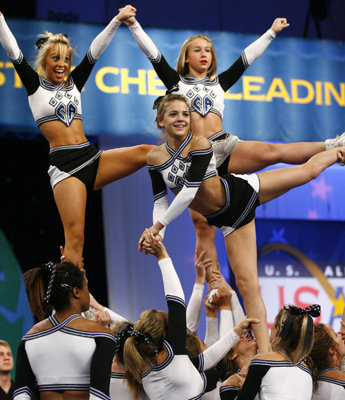Why “not” Cheer?
We often have people ask us why we got rid of our cheer program and the answer is very complex. First and foremost, our program actually left us. Complaining that a program of 39 kids should have precedent over 2 programs with much higher enrollment (Gymnastics at 600+ and Tumble and Tramp at near 100), complaining that the gym didn’t support the program. Never mind that the fact that the cheer directors refused to develop curricula, refused additional hours and were difficult to work with. Never mind that the program was supported, literallyoperating at a loss, for 5 years but kept alive in hopes of it eventually standing on it’s own. The directors who complained about our support went to work for some disgruntled team parents who opened their own gym. We were then confronted with the question of: do we start over or let the program go? We are gymnastics people. We have all been gymnasts and that’s what we do. Our interest and ability to do cheer was low, and we relied on cheer “professionals” to develop the program. That didn’t work since our cheer professionals” were not all that professional, though we did like having a program for the kids that worked so hard in their sport.
So after consideration of the conflicts we had with a few obsessive parents and several overly emotional unreliable coaches, we leaned toward “no.” Then considering that many girls might not be able to do gymnastics, but could and did participate in cheer, we wanted to have the option for them and we leaned toward “yes”. Then we had to renew our insurance. Gymnastics was expensive but nothing compared to cheerleading and we researched why. Then we decided: “no.”
You would think from judging the number of headlines on the Internet that Cheer was the most dangerous sport ever. It’s not, but it ranks pretty high. When I attended a cheer camp 3 years ago, they were “safety training” coaches and quoting statistics from 1992. It gave the impression that there was less “real” concern for today’s cheerleader. The statistics they offered reflected a time when cheer was not as popular as it is today. Probably by about 800% as cheer has grown exponentially over the last 10 years. I felt that the hosting cheer association was irresponsible and I conveyed that to my staff. Being a safety educator for USA-Gymnastics, I was entrusted to teach gymnastics safety to gym professionals and I was given last year’s data, and I’m sure if they could have provided up to the minute data, USA-G would have; it is much more responsible to it’s professionally affiliated members.
The National Center for Catastrophic Sports Injury Research based at the University of North Carolina at Chapel Hill has released its 26th annual all sports report. In addition to collecting data on catastrophic injuries in all high school and college sports, the report also contains cheerleading injury data. The latest figures are from the 2007-2008 academic year. The report defines catastrophic injuries as any severe injury incurred during participation in a school or college sponsored sport, and includes three categories: fatal; non-fatal (resulting in permanent severe functional disability); and serious (no permanent functional disability but severe injury). The report’s conclusions for the 26-year period from the fall of 1982 through the spring of 2008 include:
– There were 1,116 direct catastrophic injuries in high school (905) and college sports (211). High school sports were associated with 152 fatalities, 379 non-fatal and 374 serious injuries. College sports accounted for 22 fatalities, 63 non-fatal and 126 serious injuries. Cheerleading accounted for 65.2 percent of high school and 70.5 percent of college catastrophic injuries among all female sports. That includes, in the remaining percentage, basketball, swim, volleyball, fencing, crew, soccer, softball, badminton AND gymnastics.
The report’s author and center director, Frederick O. Mueller, Ph.D.,professor of exercise and sports science in UNC’s College of Arts and Sciences, noted that the number of cheerleading injuries fell slightly in 2007-08 year. … (must be due to educating their professional members).
Linked here: Catastrophic Sports Injury Report Released
Is Cheer a dangerous sport? Absolutely. But I dispute the findings on at least two important points. 1. They’re combining statistics from competitive Cheer with often poorly trained pompom wavers, also called Cheerleaders. 2. They also don’t include youth programs, like ours was. Though we never experienced a catastrophic injury in 5 years I can see the possibility. When kids are spotting kids there is a little bit of room for dropping each other. In gymnastics, it’s professional coaches, trained, who do the spotting.
I don’t want to disparege cheer programs, and I encourage parents to explore the local cheer programs, but keep in mind the reasons why cheer is ranked so highly in this report. Insist on quality instruction, good safety precautions and educated people directing the program. Do your homework, your child will thank you.
Excerpts taken from post of Rick McCharles and from Report available at link above.


